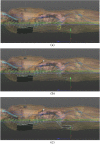Investigating the role of capacitive coupling between the operating table and the return electrode of an electrosurgery unit in the modification of the current density distribution within the patients' body
- PMID: 23937865
- PMCID: PMC3751592
- DOI: 10.1186/1475-925X-12-80
Investigating the role of capacitive coupling between the operating table and the return electrode of an electrosurgery unit in the modification of the current density distribution within the patients' body
Abstract
Background: Electrosurgery units are widely employed in modern surgery. Advances in technology have enhanced the safety of these devices, nevertheless, accidental burns are still regularly reported. This study focuses on possible causes of sacral burns as complication of the use of electrosurgery. Burns are caused by local densifications of the current, but the actual pathway of current within patient's body is unknown. Numerical electromagnetic analysis can help in understanding the issue.
Methods: To this aim, an accurate heterogeneous model of human body (including seventy-seven different tissues), electrosurgery electrodes, operating table and mattress was build to resemble a typical surgery condition. The patient lays supine on the mattress with the active electrode placed onto the thorax and the return electrode on his back. Common operating frequencies of electrosurgery units were considered. Finite Difference Time Domain electromagnetic analysis was carried out to compute the spatial distribution of current density within the patient's body. A differential analysis by changing the electrical properties of the operating table from a conductor to an insulator was also performed.
Results: Results revealed that distributed capacitive coupling between patient body and the conductive operating table offers an alternative path to the electrosurgery current. The patient's anatomy, the positioning and the different electromagnetic properties of tissues promote a densification of the current at the head and sacral region. In particular, high values of current density were located behind the sacral bone and beneath the skin. This did not occur in the case of non-conductive operating table.
Conclusion: Results of the simulation highlight the role played from capacitive couplings between the return electrode and the conductive operating table. The concentration of current density may result in an undesired rise in temperature, originating burns in body region far from the electrodes. This outcome is concordant with the type of surgery-related sacral burns reported in literature. Such burns cannot be immediately detected after surgery, but appear later and can be confused with bedsores. In addition, the dosimetric analysis suggests that reducing the capacity coupling between the return electrode and the operating table can decrease or avoid this problem.
Figures




References
-
- International Electrochemical Commission. International standard IEC 60601–1 Medical electrical equipment - Part 1: General requirements for basic safety and essential performance. 3. Geneva; 2012. (with amendment 1)
-
- Neufeld GR, Foster KR. Electrical impedance properties of the body and the problem of alternate-site burns during electrosurgery. Med Instrum. 1985;19(2):83–87. - PubMed
-
- Emergency Care Research Institute. Higher currents, greater risks: preventing patient burns at the return-electrode site during high-current electrosurgical procedures. Health Devices. 2005;34(8):273–279. - PubMed
Publication types
MeSH terms
LinkOut - more resources
Full Text Sources
Other Literature Sources

